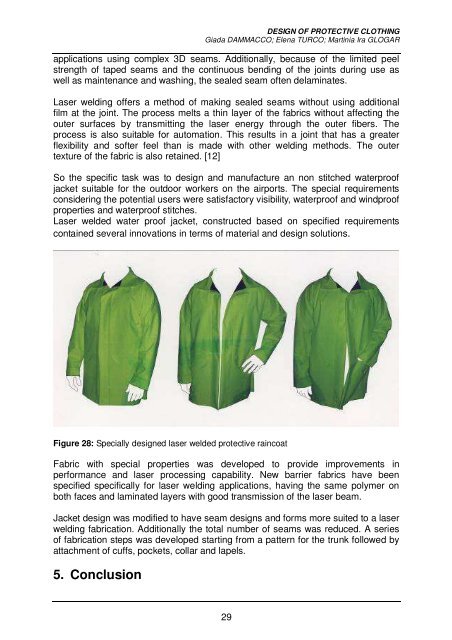Protective Clothing Design - Grado Zero Espace Srl
Protective Clothing Design - Grado Zero Espace Srl
Protective Clothing Design - Grado Zero Espace Srl
You also want an ePaper? Increase the reach of your titles
YUMPU automatically turns print PDFs into web optimized ePapers that Google loves.
DESIGN OF PROTECTIVE CLOTHING<br />
Giada DAMMACCO; Elena TURCO; Martinia Ira GLOGAR<br />
applications using complex 3D seams. Additionally, because of the limited peel<br />
strength of taped seams and the continuous bending of the joints during use as<br />
well as maintenance and washing, the sealed seam often delaminates.<br />
Laser welding offers a method of making sealed seams without using additional<br />
film at the joint. The process melts a thin layer of the fabrics without affecting the<br />
outer surfaces by transmitting the laser energy through the outer fibers. The<br />
process is also suitable for automation. This results in a joint that has a greater<br />
flexibility and softer feel than is made with other welding methods. The outer<br />
texture of the fabric is also retained. [12]<br />
So the specific task was to design and manufacture an non stitched waterproof<br />
jacket suitable for the outdoor workers on the airports. The special requirements<br />
considering the potential users were satisfactory visibility, waterproof and windproof<br />
properties and waterproof stitches.<br />
Laser welded water proof jacket, constructed based on specified requirements<br />
contained several innovations in terms of material and design solutions.<br />
Figure 28: Specially designed laser welded protective raincoat<br />
Fabric with special properties was developed to provide improvements in<br />
performance and laser processing capability. New barrier fabrics have been<br />
specified specifically for laser welding applications, having the same polymer on<br />
both faces and laminated layers with good transmission of the laser beam.<br />
Jacket design was modified to have seam designs and forms more suited to a laser<br />
welding fabrication. Additionally the total number of seams was reduced. A series<br />
of fabrication steps was developed starting from a pattern for the trunk followed by<br />
attachment of cuffs, pockets, collar and lapels.<br />
5. Conclusion<br />
29
















